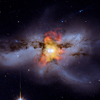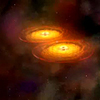CXC Home | Search | Help | Image Use Policy | Latest Images | Privacy | Accessibility | Glossary | Q&A
Tour of NGC 6240
Quicktime MPEG
NGC 6240 is a system in which two supermassive black holes are a mere 3,000 light years apart, virtually nothing in astronomical terms. These black holes -- the two bright point-like sources in the middle -- are in such close proximity, scientists think they are in the act of spiraling toward each other. This is a process that began about 30 million years ago. It's estimated that the two black holes will eventually drift together and merge into a larger black hole some tens to hundreds of millions of years from now.
[Runtime: 00:35]
Quicktime MPEG
NGC 6240 is a system in which two supermassive black holes are a mere 3,000 light years apart, virtually nothing in astronomical terms. These black holes -- the two bright point-like sources in the middle -- are in such close proximity, scientists think they are in the act of spiraling toward each other. This is a process that began about 30 million years ago. It's estimated that the two black holes will eventually drift together and merge into a larger black hole some tens to hundreds of millions of years from now.
[Runtime: 00:35]
(Credit: X-ray (NASA/CXC/MIT/C.Canizares, M.Nowak); Optical (NASA/STScI))
Black Hole Merger Animation
Quicktime MPEG
The movie shows a merger of two galaxies (simulation) that forms a single galaxy with two centrally located supermassive black holes surrounded by disks of hot gas. The black holes orbit each other for hundreds of millions of years before they merge to form a single supermassive black hole that sends out intense gravitational waves.
[Runtime: 00:43]
Quicktime MPEG
The movie shows a merger of two galaxies (simulation) that forms a single galaxy with two centrally located supermassive black holes surrounded by disks of hot gas. The black holes orbit each other for hundreds of millions of years before they merge to form a single supermassive black hole that sends out intense gravitational waves.
[Runtime: 00:43]
(Animation: NASA/CXC/A. Hobart
Simulation: Josh Barnes (U. of Hawaii)/John Hibbard (NRAO))
Return to NGC 6240 (October 6, 2009)




